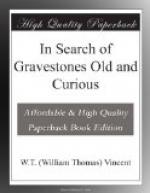[Illustration: Fig. 92. Inverness.]
[Illustration: Fig. 93. Braemar.]
Fig. 92.—At Inverness.
On the stone No. 2 the tailor’s tools—shears, goose, and bodkin—are clear enough, and I was told that the figures on the stone in the lower left-hand corner (No. 3) are locally recognized as the shuttle and some other requisite of the weaver’s trade. Inverness had spinning and weaving for its staple industries when Pennant visited the place in 1759. Its exports of cordage and sacking were considerable, and (says Pennant) “the linen manufacture saves the town above L3000 a year, which used to go to Holland.”
In the 1698 example (No. 1) the short “and” (&) leaves no doubt that W.F. & J. McP. (probably McPherson and his wife) are there buried; and the similar information is almost as certainly conveyed in the manifold cases in which appears the sign which occupies the same position in the two lower stones (Nos. 3 and 4). These, however, are all of later date, and may be set down as developments, or rather corruptions, of the original form. The same signs, however, constantly occur in all the northern graveyards.
Scotland has also its cruder form of memorial in the rough unhewn slabs of native freestone, which are used in all parts of the British Isles wherever such material is readily procurable.
Fig. 93.—At Braemar.
Two of these slabs of different degrees are seen in my Braemar sketch, but both seem of one family and serve to shew us the unconscious evolution of a doctrinal law into a national custom. The employment of initials, originally the sacrifice and self-denial of a dissentient faith, is here, as in other instances, combined with the Catholic emblem of the Cross. This little graveyard of Braemar, lying among the moors and mountains which surround Balmoral, and accustomed to receiving illustrious pilgrims whose shoe-string the poor gravestone tramp is not worthy to unloose, is still used for indiscriminate burials, and furnishes several examples of Roman Catholic interments. Wherever such are found in Scotland, bearing dates of the eighteenth century, they are usually of the rough character depicted in the sketch. The recumbent slab in the same drawing is given to illustrate the table or altar stone, which throughout Scotland has been used all through the Covenantic period to evade the Covenantic rule of the simple anonymous gravestone, for such memorials are almost invariably engraved and inscribed with designs and epitaphs, sometimes of the most elaborate character. But these are not mere gravestones: they are “tombs.”
[Illustration: Fig. 94. Stirling]
Fig. 94.—At Stirling.




